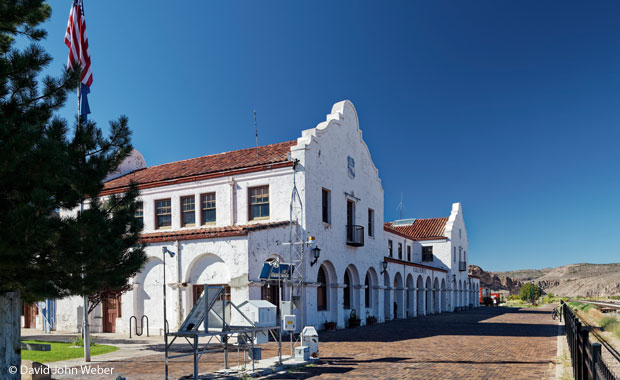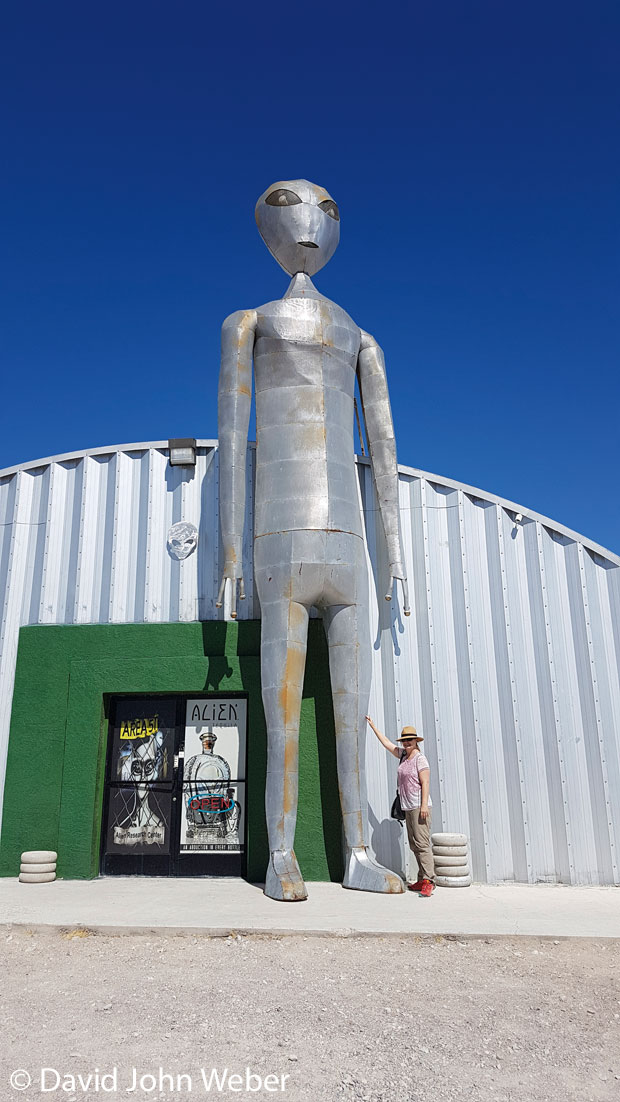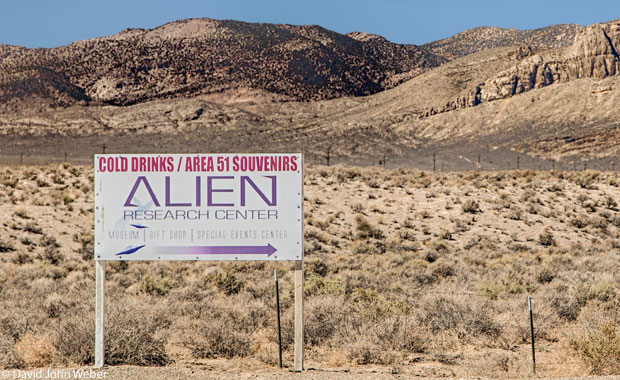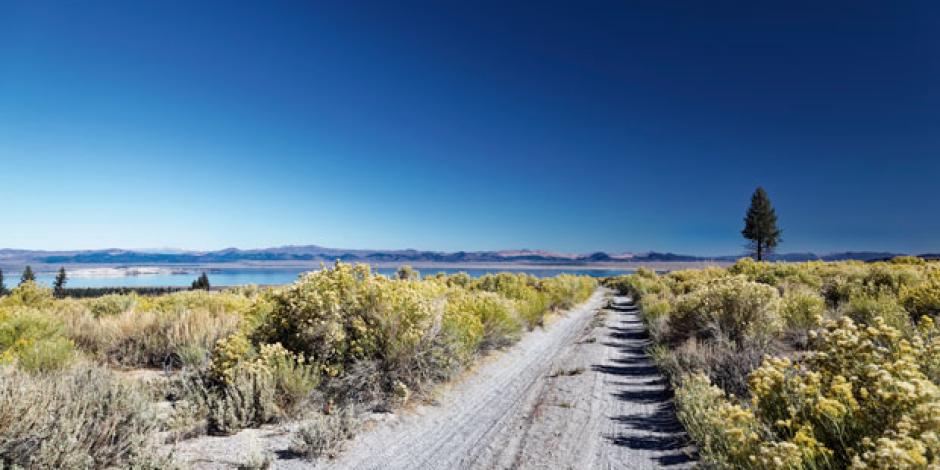Day 1
5 p.m.
We’re in a wild part of southeast Nevada, just me and my husband, driving our RV (recreational vehicle) (N. Am.)WohnmobilRV on US Route 93 to Kershaw-Ryan State Park. We arrive as it’s getting dark, pay the $15 park fee, and roll the camper into space number eight. It’s windy, but we decide to eat dinner outside anyway.
In the camper, I put butter in a pan, as well as wheat bread, cheddar, tomatoes — and voilà: toasted cheese sandwiches, a camping classic. We take our plates to a picnic table and watch batFledermausbats flying around the cliffs that rise in front of us. One cold beer later, it’s time for bed.
As we settle in, I hear the distant roar of a freight train. It gets louder and louder, until the noise to swallowverschlucken, verschlingenswallows the RV. To me, the rhythmic rattleRatternrattle of its wheels is a very American sound, as is the train’s powerful hornHupe; hier: Zughornhorn. The canyon to magnifyverstärkenmagnifies the train’s progress. I look out the window, and just past the park gate, boxcar (n. Am.)Güterwagenboxcars to flitflitzen, huschenflit by. Afterwards, all is quiet. Stars dance above, and campfire smoke is carried on the wind.
Day 2
8:40 a.m.
Kershaw is full of surprises. If you didn’t know this was a state park, you might think you were in a private garden owned by a wealthy lover of the landscape arts. A koi pondTeich, Weiherpond, perfect lawns — these are sights seldom seen in the high desert. Samuel and Hannah Kershaw established a ranch nearby in 1873, and the fruit trees and garden they planted here live on in this park. In 1934, Kershaw Gardens was given to Nevada for public use, and the state has taken care of it ever since.
As we enter the green oasis, a few minutes’ drive from the campground, we meet teenagers in Caliente Youth Center T-shirts carrying garden tools. Their work makes a difference: Flowers to gloweuchtenglow red and orange, while willowWeidewillows and white oakAmerikanische Weißeichewhite oaks present a solid picture of Baum-arborealarboreal health. A placardPlakat, Anschlagplacard among the plants tells how Civilian Conservation Corps (CCC) workers landscaped the garden during the Depression. Today, you’d never know that floods destroyed it all in 1984, though the high walls of Rainbow Canyon do to hinthinweisenhint at how gravitySchwerkraftgravity and water could to conspirezusammenwirkenconspire to create flash floodBlitzflut, Sturzflutflash floods.
9:30 a.m.
We drive two miles to Caliente, established in 1901 and named for nearby hot springQuellesprings (caliente is Spanish for “hot”). Like many small places in the rural West, it has seen better days. On Clover Street, we drive past the Shamrock Pub and a True Value hardware store (N. Am.)Eisenhandlung, Baumarkthardware store, then park at a majestic train station, the old Caliente Railroad Depot. Its twin gableGiebelgables display a coat of armsWappencoat of arms with the words “Union Pacific, The Overland Route” — once the name of a stagecoachPostkutschen-stagecoach line, and later a West-to-Midwest rail connection. In the 20th century, Caliente, halfway between Los Angeles and Salt Lake City, was an important rail hubBahnknotenpunktrail hub. These days, freightFracht-, Güter-freight trains still pass through on their way east.

The smell of creosoteKreosot, Teerölcreosote hangs in the air. A signal on the platform lights up red, then green: A freight train is coming. Two minutes later, it’s racing past, containers stackedaufgestapeltstacked two high. The end of the miles-long train is nowhere in sight. People come out of the station to watch, like witnesses to a miracle. “It’s the ‘Glory Train,’” says one, naming a popular gospel song. In the depot, they’ve been holding a church serviceGottesdienstchurch service. The woman running it explains that the old station is a rare 1920s treasure. Its architecture, called the Mission Style, to recall sth.an etw. erinnernrecalls the colonial religious outpostAußenpostenoutposts of old California, beautiful, red-tiledgefliest; hier: ziegelgedeckttiled, and arcadedmit Bogengangarcaded — the Spanish missions. She says the station once housed a 50-room hotel. Before long, the service starts up again and worshipperGottesdienstbesucher(in)worshippers return to it, gray-haired veterans among them.
I look through the station’s dusty windows: There’s a library inside with a computer terminal labeled “Lincoln County Nuclear Oversight Public Information Center,” a reminder of this state’s history of atom-bomb testing. Through another window, I see a painted map of Nevada covering one of the station’s walls. The “Creative Artists of Lincoln County” meet here and show their work. There’s an office housing the city hall, as well as a cafe, and in a separate building, the small Boxcar Museum.
10:20 a.m.
Back on US 93, a road sign tells me to expect wild horses, so I do. All I see, though, are tall cactuses. The next sign says: “Las Vegas, 149 miles.” The big city is only two hours away. Instead of going to Vegas, we turn onto State Route 375. “cattle Xing (crossing)Vorsicht ViehtriebCattle Xing next 5 miles” is nothing compared with the next roadside announcement, a metal placard covered in stickers of spaceships and slogans guaranteeing the existence of life beyond Earth. We can just about make out its name: the Extraterrestrial Highway. This is the famous, 100-mile section of the 375 that runs past the military installation known as Area 51.
11:30 a.m.
The Quonset hutWellblechhütteQuonset hut guarded by a huge metal spaceman at this end of the Extraterrestrial Highway is the alienFremdling, Außerirdische(r)Alien Research Center. Lovers of science fiction, of mysteries surrounding the 1947 UFO incident in Roswell, New Mexico, the X Files TV series, Star Trek, Star Wars, etc., would be justified in wanting more. But this is a gift shop selling cold drinks and Area 51 souvenirs, and that’s about it.
Area 51, the focus of a high-profile Facebook “joke event” in September, is a secret US Air Force base within the three-million-acreMorgenacre Nevada Test and Training Range, which occupies much of southern Nevada. The goth (ifml.)Grufti-goth store clerkVerkäufer(in)store clerk at the center entertains us with anecdotes of visitors claiming to have been to abductentführenabducted, close to the test range, by aliens. One even offered to allow this clerk to “touch her transmitter,” the one the extraterrestrials had to embedeinpflanzenembedded in her side. The Travel Channel was due to come through, the clerk added, to record part of a show about her store.

I buy socks showing an alien abduction — a person caught in a green tractor beamTraktorstrahltractor beam, being sucked up into a flying saucer — but pass on a T-shirt showing the original Star Trek crew: too retro. Salt-and-pepper shakerStreuershakers shaped like aliens call out to my wallet, as do Star Wars refrigerator magnets. The big fanhier: Ventilatorfans blowing streams of air around keep the hut’s interior cool.
Outside, the sun is high and hot. Even if aliens aren’t getting any closer, lunchtime is. We steer the RV back onto the highway, where a sign warns of “low-
flying aircraft.” It crosses my mind to let Fox Mulder and Dana Scully know, but flying objects out here are usually operated by the US military. We’re on our way to Rachel, the human settlement closest to Area 51, and its cafe, the Little A’Le’Inn (pronounced “alien”).
Along the way, a big rock proposes “Let’s get abducted” in old black graffiti. The RV rolls on. The sagebrushSalbeistrauchsagebrush-lined road leads our Winnebago spaceship into Nevada’s own weird desert dimension of space-time.
12:30 p.m.
Rachel is but a tiny group of houses, yet earthlingErdenbürger(in)Earthlings travel here in great numbers to visit its cantina. Inside the Little A’Le’Inn, I’m greeted by the sight of six real “aliens” — French tourists — all drinking cheap American beer. Area 51 bumper stickerAutoaufkleberbumper stickers and UFO-themed coffee cups are on offer here. superannuatedältlich, pensioniertSuperannuated staff, stressed by the growing lunch crowd, rush about with sandwiches on paper plates. A handwritten note on the wall says: “Now hiring, all shifts.” The menu sells “Galax wings” (low-carb) for $9.25, or a “saucerUntertassesaucer burger” with fries, same price. Cake costs $2.99. piegedeckter KuchenPie — “alien fruit,” cherry, or blueberry — costs $3.49, and there’s ice cream. Annie, our waitress, asks, “Are you writing in a diary?” I nod. “Write, ‘Annie is old.’” I do as I’m told. Another sign on the wall reads: “Beauty is in the eye of the beer holderBierhalter(in); korrekt heißt es: „beauty is in the eye of the beholder“ (Betrachter(in))beer holder.” And another: “Today is not your day, and tomorrow doesn’t look good either.”

After a long wait, Annie comes out of the kitchen with a tray full of cheeseburgers, which she delivers to the French. At the bar, Roger, a chubbyrundlich, pummeligchubby little Chihuahua, is being pushed gently out the door by his owner. The dog is picked up, kissed, then gone. The back wall of the cafe is covered with “photos” of UFOs and aliens and old pictures of real military aircraft. The two are often to conflateverbindenconflated in these parts, so it makes sense to display them together — like related species.
Annie’s back. She puts burgers and Faygo root beer (N. Am.)Limonade aus Kräuter- und Wurzelauszügenroot beers on our table. Just then, a couple in their mid-thirties comes in: He is a handsome cowboy type, and she is the loveliest creature this place has probably ever seen. The woman says to Annie, “This the lunch rush, right?” Annie, shaking her head, replies, “Still trying to figure out where they all came from.”
The couple are now running a tattoo parlor in Reno, in western Nevada, explains the pretty woman, but this has only been since she gave up exotic dancing (a recent development, it seems). This cafe hasn’t changed in the 20 years she’s been coming through, she says — even back to her younger days, when she was still touring the area on the rodeo circuit.
1:40 p.m.
After lunch, we’re on the road again. Another 90 minutes of driving, and we join US Route 6. An hour later, a sign declaring the “Tonopah Test Range” displays a blue-and-white missile much like a fast-food place would show you an oversize burger. Then we’re in Tonopah itself. The old mining town serves as a gas stop (N. Am.)Tankstellegas stop where two highways meet. I’d read that Wyatt Earp, famous Wild West lawman (N. Am.)Sherifflawman, opened a saloon here in 1902.
On the road out, an alien city appears: a shining tower surrounded by a sea of mirrors. It’s the Crescent Dunes Solar Energy Project, where the sun’s energy is collected to heat salt and generate power. Very futuristic.
6 p.m.
“Welcome to California,” says the smiling agent. She works for the agricultural border protection unit, and she’d like to check our firewood for unwanted insects. Once that’s done, she kindly tells us where we can park the RV for the night. On the horizon are the Eastern Sierra Mountains, part of the Sierra Nevada Range (Spanish for “snowy saw range”). It looks toothy, serratedgezacktserrated.
We stop at the Ida Lynn Park in Benton, California. It’s not an official RV stop, but “nobody will bother you there,” the agent had said. We park between the community centerGemeinschaftshauscommunity center and the White Mountains Bible Chapel. In the distance is Boundary Peak, 4,000 meters high.
Day 3
8:50 a.m.
On leaving Benton, we drive a rural route past hot springs, a Paiute reservation, a fine hotel, and fascinating rock formations. Soon, we enter Inyo National Forest and enjoy a broad view of the Sierras. At Mono Mills on State Route 120, a sawmillSägewerk-sawmill site that once supplied wood to silver mines, we park and walk a bit. The highlight is a fine view of Mono Lake.
10:30 a.m.
A drive down to the south side of the lake makes it easier to see its strange conekegelförmigcone islands: one white, one black. Beige tufaKalktufftufa towers, formed by springs, stand in the water near the shore. The lake is nearly three times saltier than the Pacific. They say the water is bitter to the taste and slipperyglitschig, schmierigslippery to the touch. You couldn’t pay me to drink it.
Mono Lake could be on a faraway planet, but Africa, for example, has many “soda lakes,” such as the famous Lake Natron in Tanzania. With their weird ecology, these pools — created by volcanic activity — are magnets for migratory birdZugvogelmigratory birds. Mono has been called “the busiest international airport in California.” gullMöweGulls sit on its surface, to bob upauftauchenbobbing up high like ducks. Ugly brine shrimpSalinenkrebsbrine shrimp swim in the shallowsseichtes Wassershallows, while shiny black birds stand in the oily sheenetwa: fettglänzende Oberflächeoily sheen and eat the alkali flyAlkali-, Salzfliegealkali flies. Keeping the water levels high enough to maintain the wildlife here has been a fight since 1941, when thirsty Los Angeles to divertumleitendiverted the lake’s tributaryNebenfluss, Zuflusstributaries. conservationistUmweltschützer(in)Conservationists now guard the lake carefully. After all, it’s part of a larger system, one that nature-aware California is certain to protect well into the future.
If you go
Getting there
Fly to Los Angeles (LAX) or Las Vegas (LAS).
RV rental
Book a camper through CRD.
Planning
Make reservations for campsites well in advance. Some operate on a first-come, first-served basis. Camping is also permitted on public lands, often at no cost. Careful, detailed trip planning is important for this kind of journey.
Try roadtrippers.com
Kershaw-Ryan State Park
parks.nv.gov/parks/kershaw-ryan
Mono Lake
More information
Neugierig auf mehr?
Dann nutzen Sie die Möglichkeit und stellen Sie sich Ihr optimales Abo ganz nach Ihren Wünschen zusammen.



